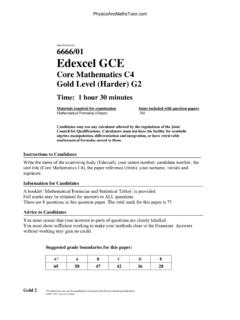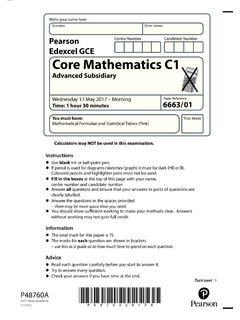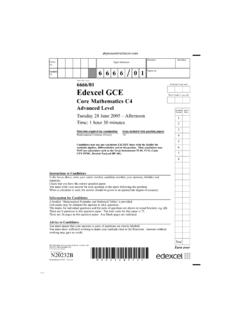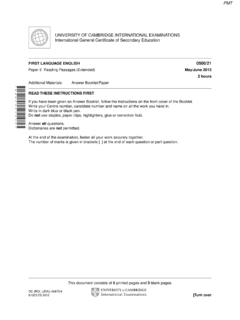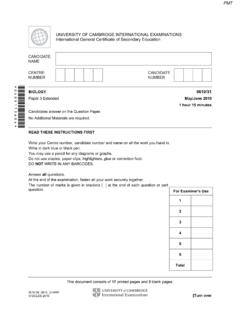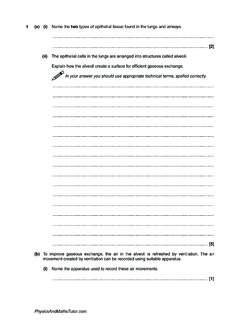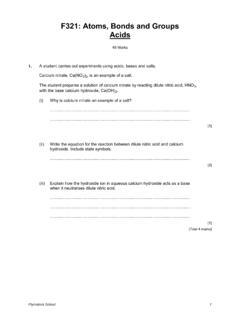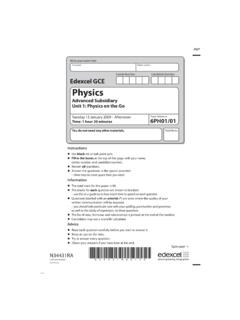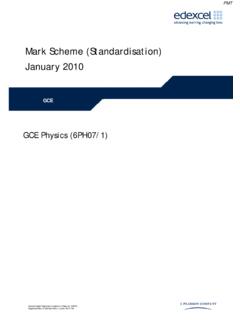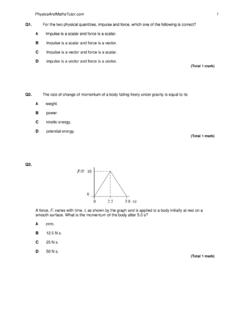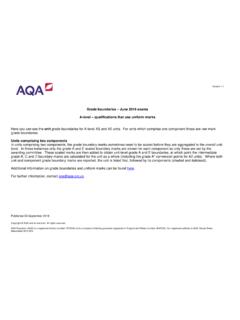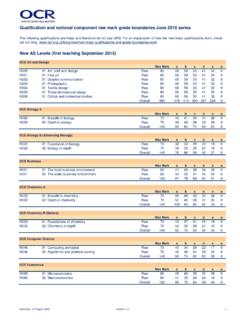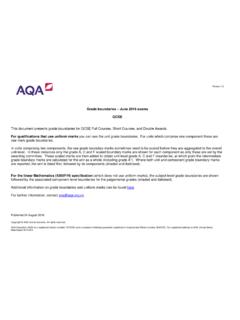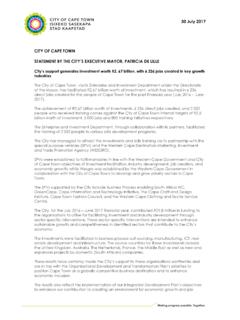Transcription of Mark Scheme (Results) Summer 2016 - Physics & …
1 Mark Scheme ( results ) Summer 2016 Pearson Edexcel GCE in Mechanics 1 (6677_01) and BTEC Qualifications Edexcel and BTEC qualifications are awarded by Pearson, the UK s largest awarding body. We provide a wide range of qualifications including academic, vocational, occupational and specific programmes for employers. For further information visit our qualifications websites at or Alternatively, you can get in touch with us using the details on our contact us page at Pearson: helping people progress, everywhere Pearson aspires to be the world s leading learning company. Our aim is to help everyone progress in their lives through education. We believe in every kind of learning, for all kinds of people, wherever they are in the world. We ve been involved in education for over 150 years, and by working across 70 countries, in 100 languages, we have built an international reputation for our commitment to high standards and raising achievement through innovation in education.
2 Find out more about how we can help you and your students at: Summer 2016 Publications Code 6677_01_1606_MS All the material in this publication is copyright Pearson Education Ltd 2016 General Marking Guidance All candidates must receive the same treatment. Examiners must mark the first candidate in exactly the same way as they mark the last. Mark schemes should be applied positively. Candidates must be rewarded for what they have shown they can do rather than penalised for omissions. Examiners should mark according to the mark Scheme not according to their perception of where the grade boundaries may lie. There is no ceiling on achievement. All marks on the mark Scheme should be used appropriately. All the marks on the mark Scheme are designed to be awarded.
3 Examiners should always award full marks if deserved, if the answer matches the mark Scheme . Examiners should also be prepared to award zero marks if the candidate s response is not worthy of credit according to the mark Scheme . Where some judgement is required, mark schemes will provide the principles by which marks will be awarded and exemplification may be limited. Crossed out work should be marked UNLESS the candidate has replaced it with an alternative response. EDEXCEL GCE MATHEMATICS General Instructions for Marking 1. The total number of marks for the paper is 75. 2. The Edexcel Mathematics mark schemes use the following types of marks : M marks These are marks given for a correct method or an attempt at a correct method. In Mechanics they are usually awarded for the application of some mechanical principle to produce an equation.
4 Resolving in a particular direction, taking moments about a point, applying a suvat equation, applying the conservation of momentum principle etc. The following criteria are usually applied to the equation. To earn the M mark, the equation (i) should have the correct number of terms (ii) be dimensionally correct all the terms need to be dimensionally correct in a moments equation, every term must be a force x distance term or mass x distance , if we allow them to cancel g s. For a resolution, all terms that need to be resolved (multiplied by sin or cos) must be resolved to earn the M mark. M marks are sometimes dependent (DM) on previous M marks having been earned. when two simultaneous equations have been set up by, for example, resolving in two directions and there is then an M mark for solving the equations to find a particular quantity this M mark is often dependent on the two previous M marks having been earned.
5 A marks These are dependent accuracy (or sometimes answer) marks and can only be awarded if the previous M mark has been earned. M0 A1 is impossible. B marks These are independent accuracy marks where there is no method ( often given for a comment or for a graph) A few of the A and B marks may be follow through marks . General Abbreviations These are some of the traditional marking abbreviations that will appear in the mark schemes . bod benefit of doubt ft follow through the symbol will be used for correct ft cao correct answer only cso - correct solution only. There must be no errors in this part of the question to obtain this mark isw ignore subsequent working awrt answers which round to SC: special case oe or equivalent (and appropriate) dep dependent indep independent dp decimal places sf significant figures The answer is printed on the paper The second mark is dependent on gaining the first mark 4.
6 All A marks are correct answer only (cao.), unless shown, for example, as A1 ft to indicate that previous wrong working is to be followed through. After a misread however, the subsequent A marks affected are treated as A ft, but manifestly absurd answers should never be awarded A marks . 5. For misreading which does not alter the character of a question or materially simplify it, deduct two from any A or B marks gained, in that part of the question affected. 6. If a candidate makes more than one attempt at any question: If all but one attempt is crossed out, mark the attempt which is NOT crossed out. If either all attempts are crossed out or none are crossed out, mark all the attempts and score the highest single attempt. 7. Ignore wrong working or incorrect statements following a correct answer. General Principles for Mechanics Marking (But note that specific mark schemes may sometimes override these general principles) Rules for M marks : correct no.
7 Of terms; dimensionally correct; all terms that need resolving ( multiplied by cos or sin) are resolved. Omission or extra g in a resolution is an accuracy error not method error. Omission of mass from a resolution is a method error. Omission of a length from a moments equation is a method error. Omission of units or incorrect units is not (usually) counted as an accuracy error. DM indicates a dependent method mark one that can only be awarded if a previous specified method mark has been awarded. Any numerical answer which comes from use of g = should be given to 2 or 3 SF. Use of g = should be penalised once per (complete) question. Over-accuracy or under-accuracy of correct answers should only be penalised once per complete question. However, premature approximation should be penalised every time it occurs. marks must be entered in the same order as they appear on the mark Scheme .
8 In all cases, if the candidate clearly labels their working under a particular part of a question (a) or (b) or (c),..then that working can only score marks for that part of the question. Accept column vectors in all cases. Misreads if a misread does not alter the character of a question or materially simplify it, deduct two from any A or B marks gained, bearing in mind that after a misread, the subsequent A marks affected are treated as A ft Mechanics Abbreviations M(A) Taking moments about A. N2L Newton s Second Law (Equation of Motion) NEL Newton s Experimental Law (Newton s Law of Impact) HL Hooke s Law SHM Simple harmonic motion PCLM Principle of conservation of linear momentum RHS, LHS Right hand side, left hand Question Number Scheme marks 1(a) tanq=520 q= q=1040 nearest degree M1 A1 A1 (3) (b) M1 A1 A1 (3) (c) Equate their j components.
9 M1 A1 M1 A1 (4) 10 1(a) Notes Allow column vectors throughout M1 for (or any other complete method) First A1 for or Second A1 for 104o 1(b) (i) (ii) M1 for clear attempt at either p or q (allow slip but t must be attached to the velocity vector and position vector and velocity vector must be paired up correctly) First A1 p = not needed but must be clear it s P Second A1 q = not needed but must be clear it s Q 1(c) First M1 for equating their j components; allow j s on both sides First A1 for t = 32 Second M1 independent for substituting their t value into their q from (b) Second A1 for p=400i + t(15i+20j)q=800j+t(20i-5j)20t(j)=(800-5t )(j)32t s=800j+32(20i-5j) =640i+640jtanq= 520 or 205 400i + t(15i+20j)800j+t(20i-5j)640i + Question Number Scheme marks 2(a) M1 A1 A1 (3) (b) Force = (N) or 15 (N)OR.
10 Force = (N) or 15 (N) M1 A1 A1 (3) OR M1 A1 A1 (3) 6 Notes 2(a) In both parts of this question use the mass which is being used to guide you as to which part of the system is being considered M1 is for an equation for whole system in T only, with usual rules First A1 for a correct equation Second A1 for or 21 2(b) First M1 is for an equation for the brick only (1st alternative) or for the scale pan only (2nd alternative) with usual rules. First A1 for a correct equation (in the second alternative T does not need to be substituted) Second A1 for or 15 If R is replaced by - R in either equation, can score M1A1. This would lead to R = or -15. The second A1 can then only be scored if the candidate explains why the ve sign is being ignored.
